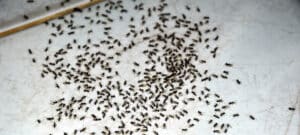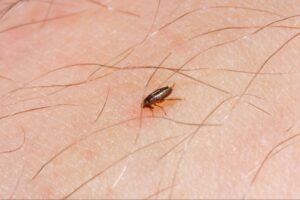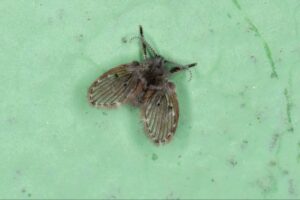Home / Blog / Fleas / What Do Fleas Look Like to the Human Eye? 3 Telling Features
What Do Fleas Look Like to the Human Eye? 3 Telling Features

Scientifically reviewed by Rachel Maldonado
-Published on May 17, 2024
-Updated on July 31, 2024
What Do Fleas Look Like to the Human Eye? 3 Telling Features
Fleas, those pesky little insects that seem to love nothing more than feasting on the blood of humans and their pets, can be a major nuisance.
Accidentally spotting one casually strolling along the edge of your couch or, worse, finding bites on your skin is enough to ruffle anyone’s feathers.
But what do these tiny terrors look like up close? In this in-depth guide, we’re peeling back the curtain to help you identify fleas in your home.
Whether you’re a pet owner, a parent, or just someone who likes to stay informed about the pests that could be lurking in the shadows, this post is for you.
What Do Fleas Look Like?
Picture a flea, and your mind may conjure something outlandishly large. After all, they wreak monster-sized havoc on our peace of mind!
But the fact is, adult fleas are minuscule. They measure approximately 1/16 to 1/8 inch – about the size of the tip of a ballpoint pen.
Their small size is not the only reason for their tough-to-spot evasiveness – their brown coloration helps them blend seamlessly into most environments. They are wingless, but can get around quite easily.
Though you might not ever look at one under a magnifying glass, a closer look at a flea reveals a body perfectly designed for survival and reproduction, featuring powerful legs built for leaping and sharp mouthparts for piercing skin.
Features Fleas are Known For
To the naked eye, fleas are merely specks of irritation, but there are some features that stand out when magnified:
1. Built for Jumping
Fleas are some of the best jumpers in the animal kingdom, able to leap over 200 times their height. Their back legs are long and powerful, full of elastic-like energy that allows them to launch into action at a moment’s notice.
2. Winning the Oscars for Parasitism
Fleas are parasitic, meaning they live off the blood of a host. Their specifically adapted mouthparts allow them to pierce the skin and gorge on blood with minimal detection.
3. Never-Ending Breeders
One of the most troubling aspects of fleas is their reproductive capability. A single adult female flea can lay up to 50 eggs a day, typically closer to an average of 27 per day, though. Over the course of her one-to-two-month lifespan, she can produce 2,000 eggs.
These eggs can fall off your pet as they move throughout your home, resting in carpets, bedding, and furniture until conditions are right for hatching.
How to Find Fleas in Your Home
Fleas are secretive creatures that shy away from light and noise, making them difficult to spot. Understanding where to look can make all the difference in identifying an infestation.
Fleas are often found in areas where pets commonly rest or sleep. Check pet bedding, carpets, rugs, and upholstered furniture. Look for signs such as flea dirt (digested blood that looks like dark specks), eggs, or the fleas themselves.
Pay close attention to your pet’s hindquarters, tail area, and stomach, as well as the areas around the collar and the ears. These are favorite spots for fleas to congregate, given the warmth and access to the skin.
In homes without pets, fleas can still be an issue. They come indoors on clothing and items, often from other homes with infestations. Areas next to doors and in bedrooms are often the first places to check.
What to Do When You Spot One
If you’ve identified a flea or suspect an infestation, it’s crucial to act quickly. Here are some steps to take:
- Control the Source: If a pet has fleas, use vet-recommended treatments to eliminate them.
- Sanitize Frequently: Wash all pet bedding, human bed linens, and any washable items in hot water. Vacuum daily and empty the bag or canister outside immediately. Steam clean carpets and upholstered furniture.
- Consult a Professional: If you can’t manage the infestation on your own, it’s time to call in the experts. Professional pest control services are equipped with the tools and experience to eradicate fleas effectively.
- Prevent Reinfestation: Continue with preventative measures, such as using flea preventatives on pets, for a sustained period. Be vigilant and repeat cleaning procedures for several weeks as some fleas may continue to hatch from eggs.
How to Keep Fleas from Coming Back
Preventing a flea infestation is always better than dealing with one.
To accomplish this, first, know that regular brushing and bathing can help you detect fleas early. Use a flea comb for more thorough inspections.
There are also many safe and effective flea prevention products for pets, from topical treatments to collars to oral medications. Work with your vet to choose the best option for your pet’s needs.
Finally, keeping a clean home can prevent fleas from finding the conditions they need to reproduce. Regular vacuuming, washing linens, and using natural repellants in the home environment can all help deter fleas.
Vacuuming, in particular, is especially important, since it picks up eggs and fleas at other life stages. However, you need to be vigilant about vacuuming and do it frequently – make sure you dispose of all the vacuum contents immediately in an outdoor trash bin, too, to prevent the fleas from getting back inside.
Key Takeaways
At Hawx Pest Control, we know all too well the nuisance and distress that unwelcome guests like fleas can cause. That’s why our expert technicians are dedicated to providing comprehensive and effective pest control services. Eradicating fleas is not just about removing the adult pests but addressing all life stages and creating a plan for long-term prevention.
If you’re battling fleas or any other pest, reach out to us for a solution that’s tailored to your specific situation. We believe in not only solving the problem but in guiding you on how best to prevent future issues.
Join the Hawx family of satisfied customers and reclaim your home from pests today.
Related Articles
Visit our blog to learn more.
→








